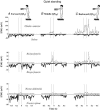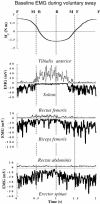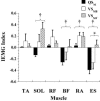Reversals of anticipatory postural adjustments during voluntary sway in humans
- PMID: 15790661
- PMCID: PMC1464531
- DOI: 10.1113/jphysiol.2005.084772
Reversals of anticipatory postural adjustments during voluntary sway in humans
Abstract
We describe reversals of anticipatory postural adjustments (APAs) with the phase of a voluntary cyclic whole-body sway movement. Subjects (n=9) held a standard load in extended arms and released it by a bilateral shoulder abduction motion in a self-paced manner at different phases of the sway. The load release task was also performed during quiet stance in three positions: in the middle of the sway range and close to its extreme forward and backward positions. Larger APAs were seen during the sway task as compared to quiet stance. Although the direction of postural perturbation associated with the load release was always the same, the direction of the APAs in the leg muscles reversed when the subjects were close to the extreme forward position as compared to the APAs in other phases and during quiet stance. The trunk muscles showed smaller APA modulation at the extreme positions but larger modulation when passing through the middle position, depending on the direction of sway, forward or backward. The phenomenon of APA reversals emphasizes the important role of safety in the generation of postural adjustments associated with voluntary movements. Based on these findings, APAs could be defined as changes in the activity of postural muscles associated with a predictable perturbation that act to provide maximal safety of the postural task component.
Figures






References
-
- Adkin AL, Frank JS, Carpenter MG, Peysar GW. Fear of falling modifies anticipatory postural control. Exp Brain Res. 2002;143:160–170. 10.1007/s00221-001-0974-8. - DOI - PubMed
-
- Aruin AS, Forrest WR, Latash ML. Anticipatory postural adjustments in conditions of postural instability. Electroencephalogr Clin Neurophysiol. 1998;109:350–359. 10.1016/S0924-980X(98)00029-0. - DOI - PubMed
-
- Aruin AS, Latash ML. The role of motor action in anticipatory postural adjustments studied with self-induced and externally triggered perturbations. Exp Brain Res. 1995;106:291–300. - PubMed
-
- Aruin AS, Latash ML. Anticipatory postural adjustments during self-initiated perturbations of different magnitude triggered by a standard motor action. Electroencephalogr Clin Neurophysiol. 1996;101:497–503. 10.1016/S0921-884X(96)95219-4. - DOI - PubMed
-
- Aruin AS, Shiratori T. The effect of the amplitude of motor action on anticipatory postural adjustments. J Electromyogr Kinesiol. 2004;14:455–462. 10.1016/j.jelekin.2003.12.002. - DOI - PubMed
MeSH terms
LinkOut - more resources
Full Text Sources
Medical

